Torn apart by a civil war
The case of the Spanish Navy during the interwar is one of a fleet from a major player torn apart by a civil war. The only closest example could be the American Secession war, at a very large scale, or more recently, the French case in WW2 where the fleet was split between the Free French and Vichy loyalists. But the case of the Armada is unique, in which modern cruisers, destroyers, gunboats, submarines and aviation were involved in a modern in-fighting between the Republicans and Nationalists.
This story is about the state of the Spanish Armada after WW1 (where the country remained neutral), new construction programs and modernizations, and of course the divide between the two sides from 1936, ships captured, battles, and losses until 1939. This will be concluded by the Armada under Franco during WW2 and naval programs of that era.
Articles Published & upcoming:
- Blas de Lezo class cruisers (1922)
- Canarias class cruisers
- Cervera class cruisers
- Cruiser Navarra (1920)
- España class Battleships (1912)
- Seaplane carrier Dédalo (1920)
- WW2 Spanish Destroyers
- WW2 Spanish Submarines
Spanish Gunboats
Spanish Minelayers
The state of the Armada in 1918
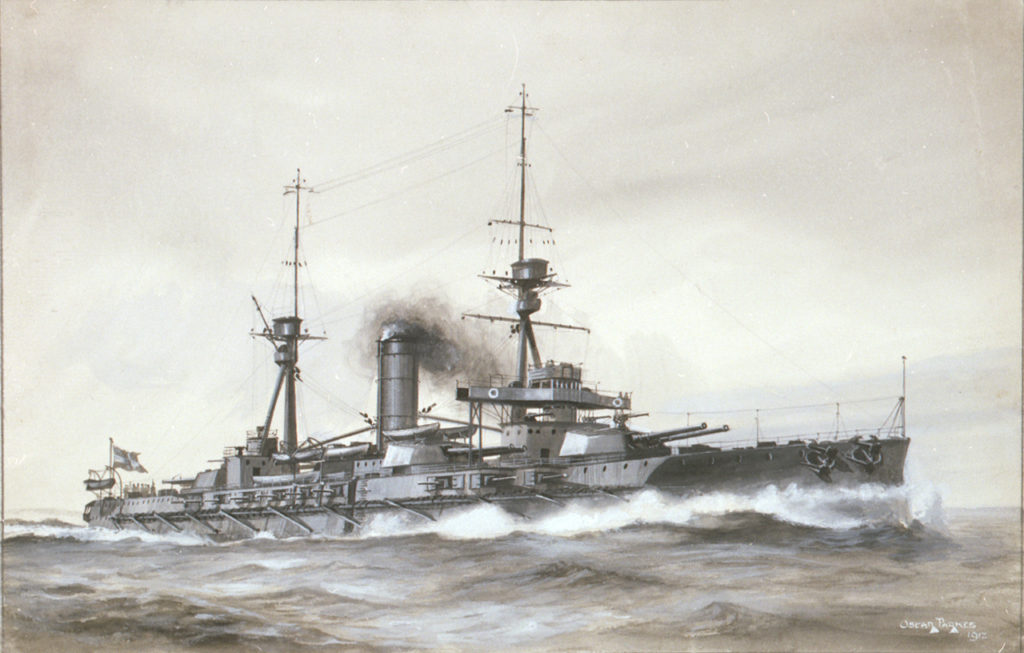
In 1908 the Spanish Government set up the shipbuilding and armaments company Sociedad Española de Construcion Naval (SECN) with the primary purpose of reconstructing the Navy after its heavy losses in the Spanish-American War of 1898. To provide finance and expertise a 24.5 per cent share of this company was sold to the three British firms of Vickers, Armstrong and John Brown, who provided not only modern designs but also skilled overseers for the Spanish yards. In 1925-29, a wave of retirements saw a large part of the “old armada” going to shipbreakers: Pelayo, a 1890s battleship, the cruiser Emperador Carlos V (1895) in 1933, The Cataluna class Princesa de Asturias and Cataluña (1896 and 1900) in 1929, the Rio de la Plata (1898), rebuilt as a minelayer, in 1929, the Estramadura (1900) in 1930, the Reina Regente (1906) in 1929.
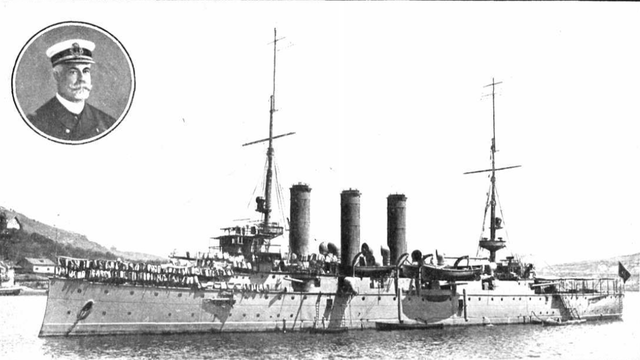
Cruiser Reina Regente (discarded in 1939), here in 1912.
Former destroyers of the 1898 spanish-american war generation were also discarded: The four Audaz class Ausaz, Osado, Proserpina and Terror in 1924-31 and the pre-ww1 Bustamante class Bustamante, Cardaso and Villaamil in 1930-32. Torpedo Boats of the 177 tons 1912 type were also discarded for some in 1931-32 (1, 5, 6, 8, 10, 11, 12). One was lost during the civil war (N°3 see below) and the other discarded either in 1939 or during and after WW2. The oldest Spanish submarine, Isaac peral (1916) was hulked in 1930 and renamed A0. Laurenti-Fiat Type submarines of 1917, the 217 tons Narciso Monturiol, A3 and Cosmo Garcia were discarded in 1930. However the 1921-23 Holland type B class were still in service for most of the civil war (see below).
The oldest gunboats of the 1910 Recalde class (Bonifaz, Lauria, and Recalde) were discarded in the 1930s but Laya took part in the civil war, sunk in action in 1938 (see below). The more modern 1922, 1314 tons Castillo class (Antonio Canovas del Castillo, José Castalejas, Eduardo Dato) were also active during the civil war and scrapped mush after ww2.
Interwar rebuilding
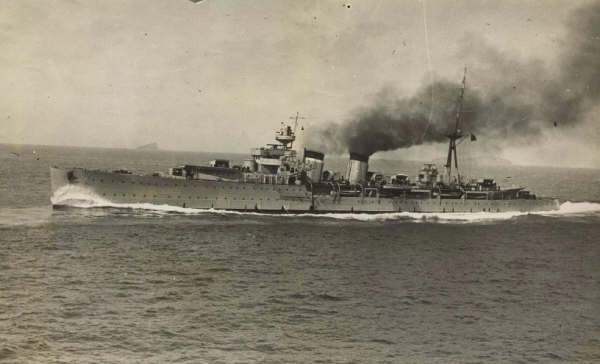
The Almirante Cervera class was a take on post-ww1 British design, and the last Spanish light cruisers to enter service. Older cruisers of the pre-ww1 design generation would be completely rebuilt like the Navarra in 1937-38 and the Mendez Nunez during WW2.
Shipbuilding facilities were provided at Ferrol and Cartagena, and all subsequent major Spanish warships were built in these two yards except for the destroyer Churruca, launched in 1925 at
a new yard in Cadiz. The rebuilding programme began slowly, but between 1922 and 1930 8 cruisers, 16 destroyers and 12 submarines were either completed or put in hand.
The world depression brought a halt to further plans and greatly delayed the completion of those ships still under construction; before the Spanish economy had recovered from this setback the Civil War brought a complete halt to further naval expansion.
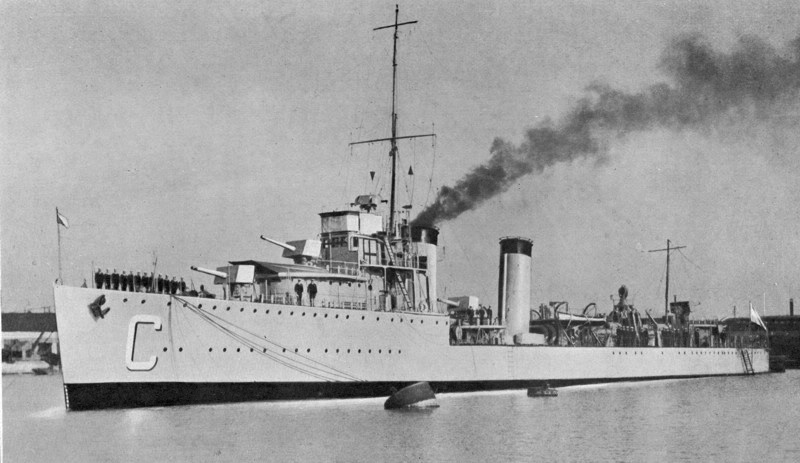
ARA Cervantes, former Churucca, sold to Argentina in 1927 as well as the Galiano. This class comprised 18 ships in all, built in three groups, a considerable effort for the Spanish naval industry. They were conform with the British 1915 Scott class flotilla leaders.
Battleship España in 3D
The Spanish civil war (1936-39)
![]()
![]()
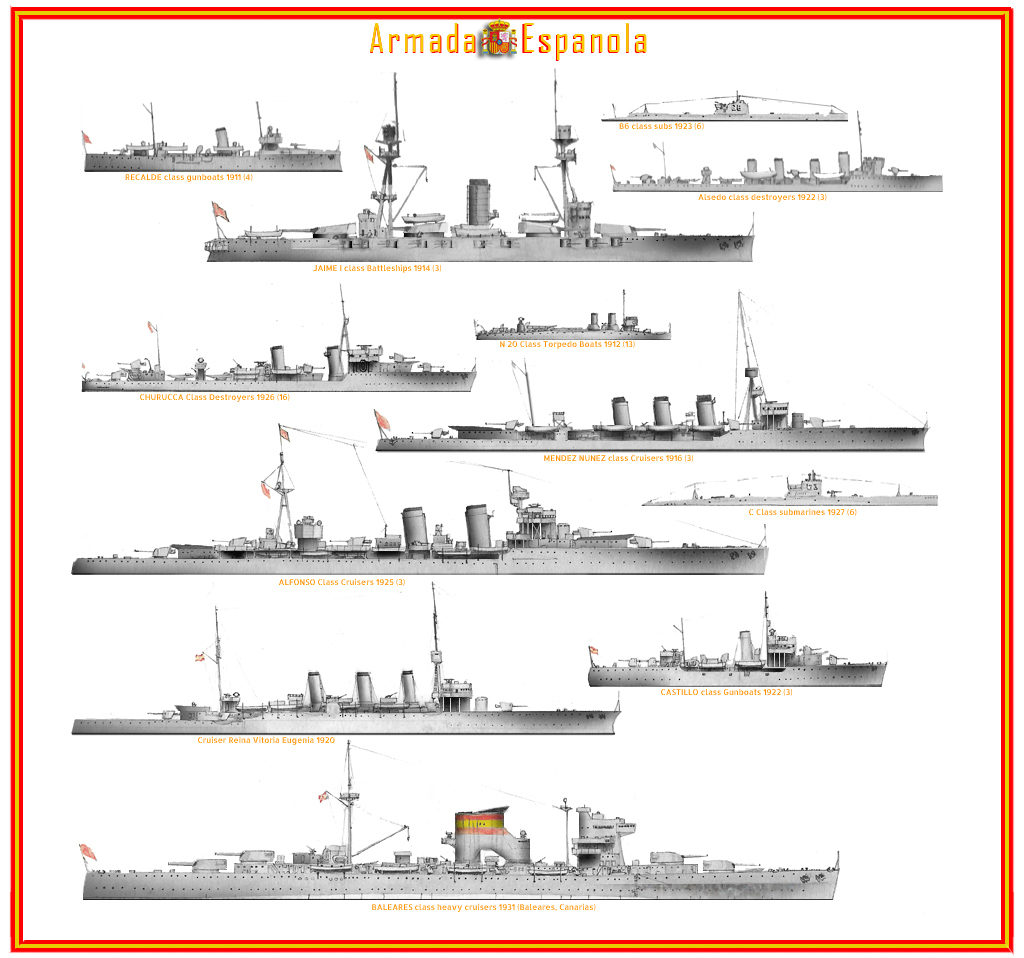
Cases of civil wars when ships on both side fought in battle it quite rare, especially in modern times. There were a few occurences of in-fighting during WW2 between Free French and Vichy French naval forces, or die-hard Fascists of the “Social Republic” against Italians fighting with the allies, but they saw little naval clashes. However to find naval battles of the scale of the Spanish civil war, the only equivalment that come to mind was the Secession war, 74 years before. In this battles, Battleships, cruisers and destroyers were engaged, mostly in order on one side (mostly the nationalists) to disrupt merchant traffic and any reinforcements to the Republicans, clashes resulting of opposite squadrons sent to intercept this raiding force.
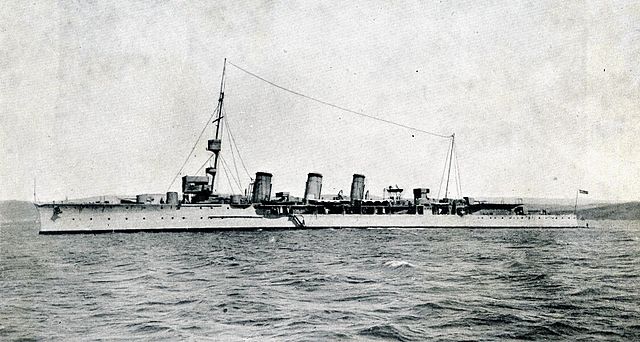
Spanish cruiser Blas de Lezo in the 1920s. The Rif war in Morocco saw the Spanish navy carrying out close support coastal operations, often combined with aviation obervation provided by the Dedalo, first Spanish seaplane carrier.
The Spanish Navy’s primary functions were the defence of the Spanish coast and the Balearic and Canary Islands, trade protection, and commerce raiding. Cruisers and destroyers were provided to fulfil all these requirements and were backed up by gunboats, for coast defence and escort duty, and submarines, for commerce raiding. Providing a balanced and modern force was however hampered by Spain’s weak financial position, and the considerable disruption of a civil war, which both limited the number of ships that could be built and resulted in extended construction times.
The latter, of course, meant that even though ships might be fully up-to-date when authorised they were often out-of-date when actually commissioned. On the outbreak of the Civil War on 17 July 1936 the major part of the Navy was under the control of the Republican Government but the majority of naval officers supported, the Nationalist cause, the command and organisation of the ships fel mainly to lower deck personnel, considerably weakening its effectiveness.
Early in the war the Nationalists captured the naval bases at Ferrol and Vigo together with the battleship España and the cruisers Cervera, Canarias and Baleares, the last two still incomplete at that stage. Indeed, after securing Ferrol in Galicia, the Nationalists in July lost many troops during the in-fighting which happened in the harbour while 30 officers had been shot by hundreds of sailors loyal to the Republic. The latter fought hard and eventually surrended, short of ammunitions. The Nationalists were able to seize no less than the bulk of the Spanish fleet, battleship España, cruisers Almirante Cervera, Canarias and Baleares, Navarra, a destroyer, torpedo boats and gunboats.
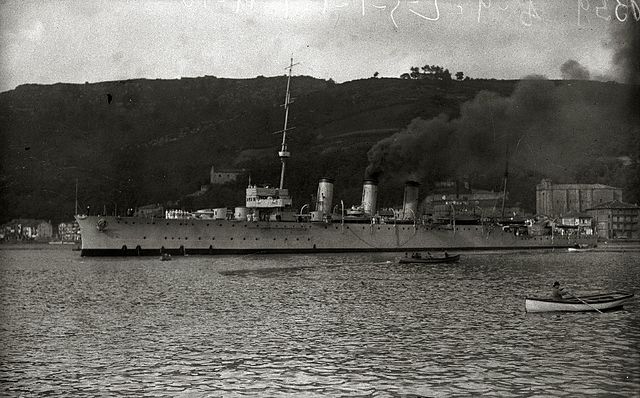
One of the two ships of the class Blas de Lezo sailing from the port of Pasaia to the African coast in 1924
The Spanish Republican Navy could still count by then to enforce it on the battleship Jaime I, three light cruisers, 14 destroyers, and five submarines. This was more than enough on paper, as the Nationalists could not count on their weak aviation to strike. In 1937 the Nationalists would be able to complete the Baleares and Canarias and purchase four destroyers and two submarines from Italy. Their tactic from 1937 was to operate the same blockade against Republican-held coastline, with limited effectiveness.
The Republican fleet took the logical step of blockading the Straits of Gibraltar to prevent the transport of General Franco’s army by sea from Morocco to the Spanish mainland. However, for some inexplicable reason they departed for the Bay of Biscay in September 1936 leaving only two destroyers in patrol. Canarias and Cervera cleared the Straits by sinking Ferrandiz and damaging Gravina, allowing Franco to transport 8000 troops by sea for the assault on Madrid. This was the only major effort involving warships during the Civil War, and neither this nor subsequentevents were particularly spectacular. Both sides concentrated their naval energies on protecting their seaborne lines of supply while secondary duties directed towards attacks on commerce (usually by submarines) and bombardments and other harassing tactic on the coast.
In the end for July 1936 the Spanish Army of Africa was still isolated in Spanish Morocco but they would manage to airlift their troops from Africa to Andalusia with the help of the future axis powers, Germany and Italy. This was the first airlift of troops in history. But Franco was decided to lift the blockade and cross in force the strait in August with a convoy of merchant ships, carrying 2,500-3,000 soldiers. This ended with a naval engagement with the only Republican destroyer present, in vain because of local aviation. The Republicans would lost their control of the sea between Morocco and the mainland for the remainder of the war.
The most significant naval battle, off Cape Palos ocurred during the night of 5-6 March 1938, but was short and indecisive. It happened occurred only because the two forces involved had run into each other accidentally. The only concrete result of it was the sinking of Baleares.
Battle of Cape Spartel (29.09.1936)
This early battle of the civil war was a crucial victory for the Nationalists as it broke the Republican blockade of the Strait of Gibraltar, allowing Franco’s troops to receive supplies from Germany. In September a Nationalist squadron in Ferrol, comprising Almirante Cervera and Canarias, were ready to take on the Republican blockade. They engaged a squadron of Republican destroyers on the western end of the Straits at 6:30 am. Gravina was caught off Cape Spartel, Almirante Ferrándiz off Ceuta, duelling with the Nationalists.
Without surprise, Almirante Ferrándiz was sunk by Canarias in the Alboran Sea, after duelling for about 40 minutes, and Gravina was badly hit twice by Almirante Cervera off Morocco but was finished off by the Canarias’s main guns from (20 km; 13 mi). Ferrándiz sank 18 nautical miles south of Calaburras, with thirty-one survivors rescued by Canarias, and 26 by the French liner Koutubia, including captain José Luis Barbastro Jiménez. That was a brave nut unequal fight. At no point the Destroyers tried to close the distance and try to torpedo both ships.
Battle of Cape Machichaco (04.04.1937)
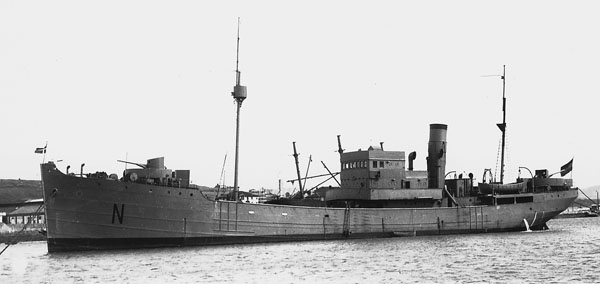
The Basque armed trawler Nabarra – Source: Shipbucket, from marinavasca.eu.
Four armed trawlers of the Basque Auxiliary Navy named Bizcaia, Gipuzkoa, Donostia and Nabarra sailed from Bayonne (France) to escort the transport ship Galdames. Canarias sailed from Ferrol (Salvador Moreno) to intercept her. However during the night, the Galdames had its lights and radio turned off for safety and lost sight of the Bizcaya and Gipuzkoa. The next morning, the trawlers were now warned of the coming Canarias, and Galdames eventually spotted them and was reunited with her escort. The trawlers’s captains had a reunion and decided to lure out Canarias close to the Biscay coast, taking advantage of the coastal batteries.
First to fight, Gipuzkoa spotted the Nationalist cruiser 30 kilometers (19 mi) north of Bilbao, and later was hit on the bridge, forward gun but replicated when close enough. Badly beaten, she escaped towards the coast, coastal batteries repelling the approach of Canarias to finish her off. Later she would assist the Estonian transport Yorbrook. Meanwhile the other trawlers tried to attack the cruiser. Donostia was hit and retired to a French port where she was interned. Nabarra faced the enemy for almost two hours but sunk. Gipuzkoa was also badly damaged and retired to Portugalete. In the end, Canarias captured the survivors of Nabarra and the transport Galdames, which failed to deliver its supply to the Basques.
Battle of Cape Cherchell (07.09.1937)
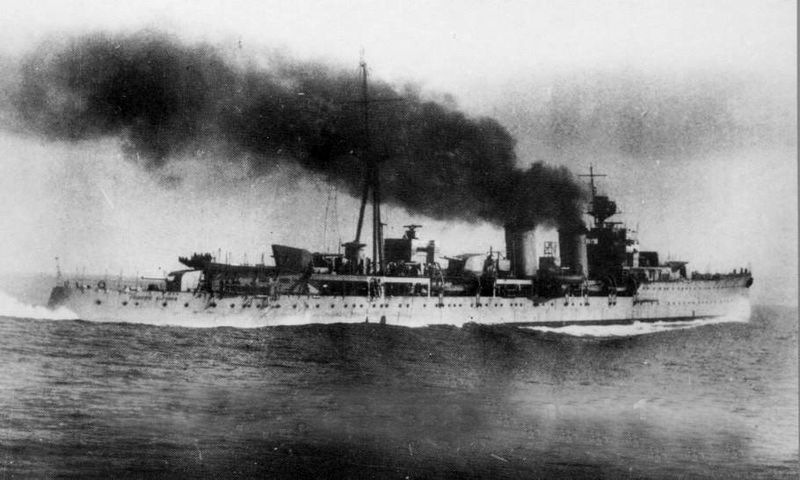
Cruiser Principe Alfonso (renamed Libertad) which took part in the fight, scoring many hits on the Baleares. Despite of this, the convoy was lost and the commander sacked.
The Nationalist heavy cruiser Baleares (Manuel Vierna Belando) and Spanish Republican light cruisers Libertad and Méndez Núñez (Commander Miguel Buiza) clashed off of the Algerian city of Cherchell, in the early morning hours of 7 September 1937. Baleares crossed (without searching for it) a Republican convoy (two cargoes, escorted by cruisers and destroyers).
The biggest danger for the convoy was not Baleares itself, but Nationalist shore-based aircraft that might have appeared when the Nationalist cruiser had radioed the convoy’s location. Because of this, the four destroyers quickly broke off the engagement and continued to escort the merchant convoy.
Steaming ahead, Libertad and Méndez Núñez engaged Baleares, destroying the Nationalist heavy cruiser’s furing control and therefore disabling the main guns direction, but the crews were able to repair the damage and resume the fight in the afternoon. Libertad scored two more hits on the Baleares which then limped off to wait for the arrival of Canarias. However the Republican convoy wasr attack by Nationalist aviation, Italian bombers of the Aviación Legionaria (Regia Aeronautica), but they failed to score any hit. However the fight caused the captains of the two freighters to panick, change course south, one running aground in Cherchell, the other taking refuge in Bona, interned by French authorities.
Convoy de la Victoria (05.08.1936)
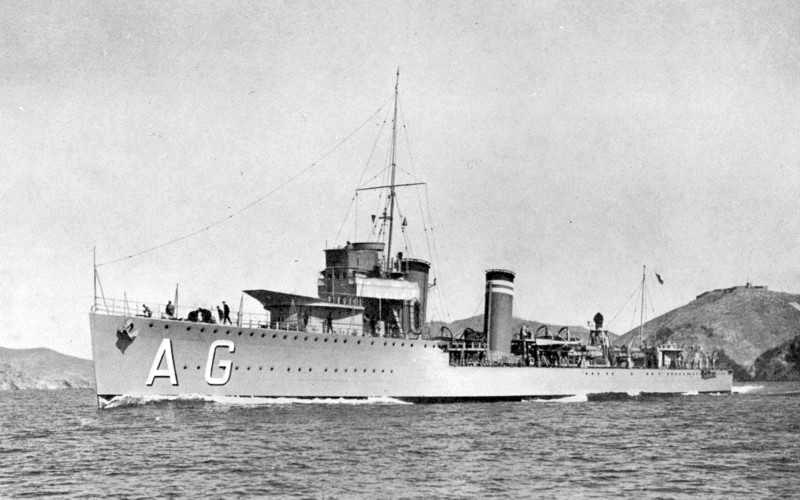
The Republican destroyer Alcala Galiano, which tried to stop the convoy but was repelled and later badly hit by aviation.
This was the second clash in the straits of Gibraltar: A Nationalist convoy comprising a gunboat (Dato), a torpedo boat (T19) and a coastguard ship (Uad Kert) escorted four transports loaded with troops from Africa. This was about 3,000 men plus their heavy equipment and weapons, sailing from Ceuta. Over them were flying a composite squadron made of five Savoia-Marchetti SM.81 bombers, three Fokker F.VIIs, two NiD.52 fighters, two Dornier Do Js, and several Breguet 19s.
Destroyer Lepanto, chased of Gibraltar by the British Authorities was driven back by Nationalist aviation and only Alcalá Galiano could engage the convoy. There was a gunnery exchange, but the destroyer did not close to torpedo ranage and retired, without seriously stopped the Convoy, which arrived as planned Algeciras in the early morning. However Dato mistook the British Destroyer HMS Basilisk, which looked like the Spanish one (same design), which almost trigerred a diplomatic storm. Alcalá Galiano was retiring towards Málaga for repairs and supply when she was attacked en route by Nationalist aviation and bombed, loosing 18 while 28 more were badly Wounded.
Battle of Majorca (16.08.1936)
The conquest of Nationalist-held Balearic islands was a strategic step to renew the blockade for Madrid’s government, from the atlantic. Plans were made early in August for a seaborne attack, Palma and Cabrera were hit by air attack and a poorly executed expedition against Cabrera from Menorca failed. Eventually later 400 Catalan militia occupied Cabrera while Bayo’s expedition failed due to internal political dissentions.
However on August 16, he would launch a large amphibious assault supported by the Spanish Republican Navy, a force of 1 battleship, 1 light cruiser, 2 destroyers and 3 submarines. They ecorted transports loaded with some 8,000 militias and 10 artillery pieces. Almost unopposed, they landed at Punta Amer and Porto Cristo. Facing them, the Nationalists could only provide 3,500 men, including 1,200 regulars, 300 Guardia Civil, and about 300 Falangist volunteers. They were assisted by three bombers and fighters but lacked artillery or even mortars and machine-guns.
The Republicans were able to eventually deploy their artillery and pushed 12 kilometres (7.5 mi) inland. However from August 27 the situation reversed completely thanks to Italian reinforcements, notably a whole squadron which destroyed Republican aviation and was able to provide a solid support during the counterattack. On September 5, the Republicans retreated and the island fell back to Nationalists hands, followed later by Ibiza, Majorca, and Formentera.
Battle of Cape Palos (05-06.04.1938)
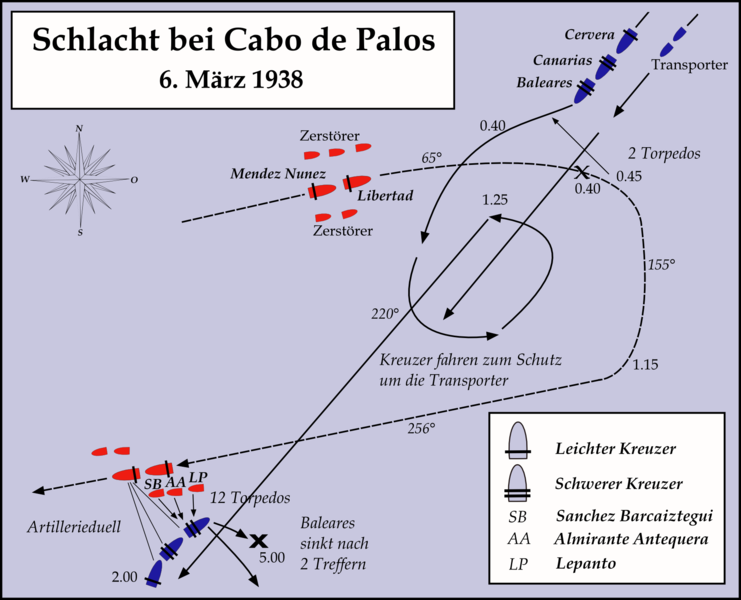
The largest naval battle, but also the last of the civil war, saw a Republican victory, but to no avail in the larger strategic picture. The Repubicans deployed 2 light cruisers and 5 destroyers and 2 Nationalist heavy cruisers (Canarias class) and 1 light cruiser (Cervera), three destroyers led by Vice Admiral Manuel Vierna Belando. They made a sortie from Palma de Mallorca, in order to act as a distant escort of a convoy from Italy. The same day, Admiral Luis González de Ubieta sailed from Cartagena with the cruisers Libertad and Méndez Núñez plus five destroyers. Both forced met by chance during the night of 5–6 March 1938.
But at this point, the Nationalists had reached their autonomy limit and leaved earlier, leaving the cruiser without protection. An advantage the Republicans were quick to recoignise. Until then as previous clashed showed, Destroyer captains rarely tried torpedo attacks. This time, a Republican destroyer fired torpedoes (but missed) at midnight. The Nationalists went on without changing course, waiting for daiylight to count on their superior heavy artillery, but with the Republicans chasing them.
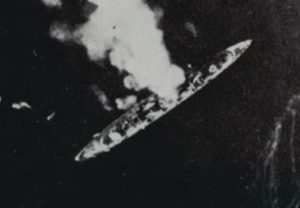 About 02:15 the forces clashed again, at about 5,000 m (5,500 yd) allowing the Republican cruisers to hit their Natonalist adversaries. In the panic, one officer apparently shot a star shell, illuminating the Nationalists, grealty helping the Republican gunners. As a result, the heavy cruisers Canarias and Balears started to take punishment whereas three Republican destroyers detached from escorting Libertad made a stealthy move towards the Nationalists’s cruisers, eventually launching each their whole torpedo loads.
About 02:15 the forces clashed again, at about 5,000 m (5,500 yd) allowing the Republican cruisers to hit their Natonalist adversaries. In the panic, one officer apparently shot a star shell, illuminating the Nationalists, grealty helping the Republican gunners. As a result, the heavy cruisers Canarias and Balears started to take punishment whereas three Republican destroyers detached from escorting Libertad made a stealthy move towards the Nationalists’s cruisers, eventually launching each their whole torpedo loads.
The Sanchéz Barcáiztegui, Lepanto, and Almirante Antequera hit Baleares between ‘A’ and ‘B’ turrets, right into a magazine that exploded. The cruiser broke in two and sank. He was alone then, Admiral De Vierna sending his two surviving cruisers out to join the convoy. There was nobody at first to take care of the survivors of the Baleares, of which 765 likely drowned. Howevr Kempenfelt and Boreas rescued later about 441. The battle was a propaganda coup for the Republicans and Luis González de Ubieta was awared the prestigious Placa Laureada de Madrid while ships were awarded the Distintivo de Madrid.
However, if the Nationalists were now reduced to a single valuable warship, the convoy has been saved and the strategic situation worsened on land. The Republican Navy failed to press their advantage and the Nationalists eventually replaced their loss with the brand new rebuilt cruiser Navarra. In addition, the latter praised the heroic behaviour of Manuel de Vierna y Belando, which decided to stay alone to save the fleet and sank with his ship.
The Civil War ended on 28 March 1939 with Spain in a disrupted and greatly depleted condition. Financially she was very weak and subsequent plans to reinforce the Navy were hampered by considerable delays in the provision and construction of new ships, due not only to limited funds but also to fluctuations in the availability of those funds. This situation was to continue with but little improvement until Spain received US assistance in the 1960s (See below for the situation during ww2).
THE BASQUE NAVY
During the Civil War the Basque Government, which was allied to the Republican cause, ran its own small naval force. It was complete independent of the main Spanish Fleet and consisted entirely of small mercantile conversions, mostly armed trawlers and coastal fishing vessels, employed as gunboats and minesweepers.
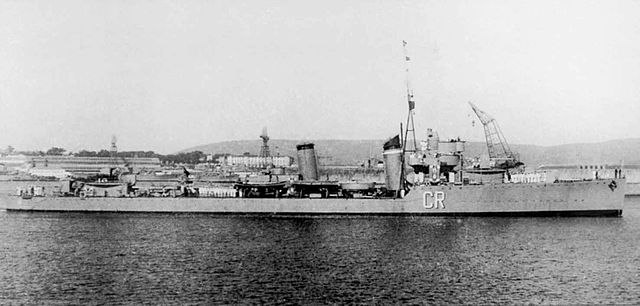
Destroyer Ciscar of the Basque Navy (cc)
One of these vessels, Donostia (ex-mercantile Virgen del Carmen), was originally a purpose-built British naval trawler, George Darby of the Castle class built in 1918. She took part in a fierce and desperate fight off Cape Machichaco (04.04.1937) as well as the Nabarra, which sank in the process.
The largest ships in the force were the auxiliary vessels Guernica and Galdemes (3717t), and the deep-sea trawlers Bizkaya (both 1,190t), Nabarra (1,204t) and Guipozco which was sunk by aircraft in 1937 but was salvaged by the Nationalists and repaired and renamed Alava until the end of the war;
Nabarra was sunk and Galdemes captured by the cruiser Canarias in Mary 1937; Guernica was sunk by a Nationalist auxiliary warship in 1938. There were other vessels of less than 400t, of which about 7 were lost from various causes.
Outside classic naval battles, ships losses reflected all the varieties of naval warfare possible: Gunnery duels with coastal fortifications, mines, and air attacks. Submarine warfare was limited due to the lack of this type on both side, but active, also against merchant traffic, which went on unescorted and on an individual basis, at least for non-Spanish ships. Indeed exports and imports never ceased during the war.
And Soviet hardware was delivered more quickly and efficiently by both sides through cargo ships rather than by railways. There is no doubt a train convoy of Italian or German tanks and artillery would have been blocked by French authorities.
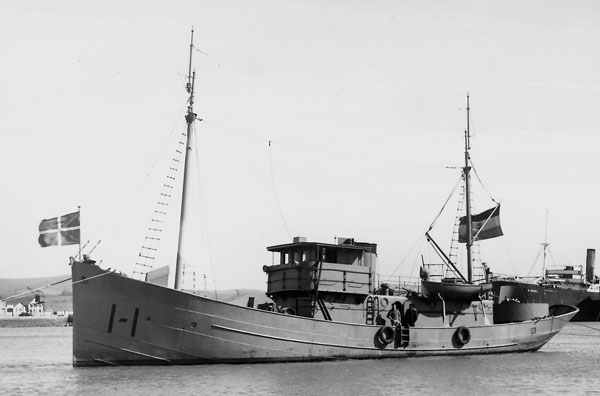
Designs and Projects
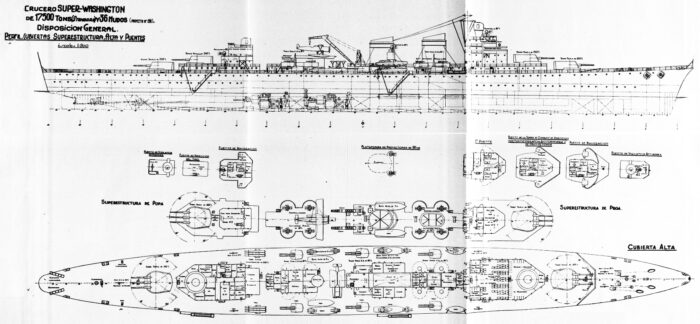
17500t “super washington” Cruiser
Republican Naval Forces in 1936
On paper, the Republican (legitimate) navy was overwhelmingly superior to the few ships the Nationalists were able to catch on their way to Spain. But soon, with the capture of coastal areas, arsenals and ports fell into their hands and naval balance began to shift, up to a point where the Nationalists were able to cause serious disruption in Republican shipping up to dully fledged naval battles (see above).
 Battleship Jaime I
Battleship Jaime I
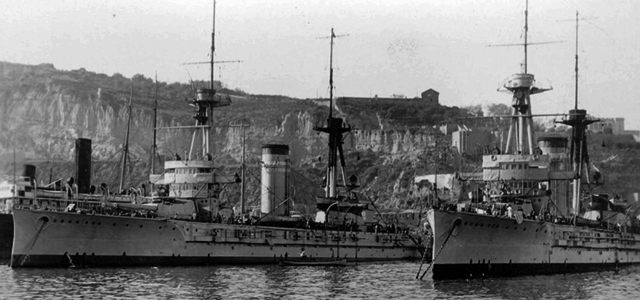
Jaime I was the last Spanish battleship completed and entering service, long after the end of WWI. She participated in the Rif war and in 1936, was listed with the Republican Navy. However Jaime I and other ships were alerted or Franco’s coup. Crews mutinied against officers generally sympathetic to the Nationalist cause and they stayed under Republican control. Jaime I will soon attack Nationalist coastal cities, shelling Ceuta, Melilla and Algeciras. She entered Algeciras and sank the gunboat Eduardo Dato. She was damaged however by Nationalist air attack at Málaga on 13 August 1936. In May she was drydocked to repait her bow and attacked several times there, delaying the completion of repairs.
In June 1937, an accidental internal explosion devastated her. Although there were suspicion of sabotage, the crews of the battlehips, which get rid of their officers was quite lacking discipline and drills. Teams failed to contain the fire, which spread to the whole ship and the explosion mught have been accidental indeed, due to carelessness. She was written off after it was found repairs would be impossible and too costly. On 3 July 1939 she was unlisted and broken up in 1941 while her guns found their way in various uses until the end of the war.
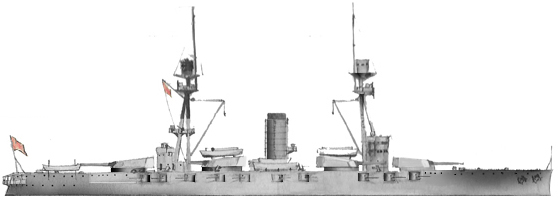
 Blas de Lezo class cruisers (1922)
Blas de Lezo class cruisers (1922)

Mendez Nunez class – Author’s illustration profile
Built under the February 1915 naval law, these two ships were closely based on the British ‘C’ class design light cruisers, and were laid down at Ferrol Dyd in March and September 1917, but due to the lack of supplies, and shipbuilding parts construction dragged on. They were launched in 1922-23 and completed in 1924-25, already obsolete. They received 12 boilers, of which six were oil-fired and the rest coal and carried 780 tons of the latter for 492 of oil.
The class was to comprise four ships, but the last two were cancelled in 1919. In 1926, Blas de Lezo supported the transatlantic flight from Spain to Buenos Aires of a four-man Spanish Air Force crew (led by Ramón Franco) in the Dornier Do J Wal. Blas de Lezo was later gounded on the Centrollo Reef of Cape Finisterre at speed on 11.7.1932, relfloated, and later sank in deep water.
Mendez Nunez which participated in the same exercizes was also badly damaged but survived. She was based in Equatorial Guinea when the Spanish Civil War broke out. She returned home to join the Spanish Republican Navy but at the end of the war, following the 1939 Cartagena Uprising she was interned in Bizerte and seized by French authorities. The ship was later asked for by the new regime and took in hand in 1944 for a complete reconstruction as an AA cruiser (see later).
 Alfonso class cruisers (1925)
Alfonso class cruisers (1925)

Alfonso class – Author’s illustration profile
Still under the February 1915 law, three cruisers designed by Sir Philipp Watts based on the British “E” (Enteprise class) light cruisers then in construction were provided but construction was postponed until several years after. Principe Alfonso indeed was only ordered on 27 July 1922 at Ferrol DyD, followed by Almirante Cervera in October 1925 and Miguel de Cervantes in May 1925, basically using the same basin. Contrary to the British “E” class, their engines compartments were closer together and better spaced, so the intakes ended in two equal funnels and the ships were regarded generally as more coherent and elegant than their British counterparts.
The other big difference was their artillery of eight 150 mm guns (6 in) spread in twin and single turrets. The three twins were in the inner hull (B, X positions and center, behind the aft funnel) and two singles on the outer hull, fore and aft. The hull also was different in which it was narrower but longer, and additional AA gun provided and the superstructure modified. However the machinery was identical to the E class and armour was also the same, with the same scheme, repartition and thicknesses.
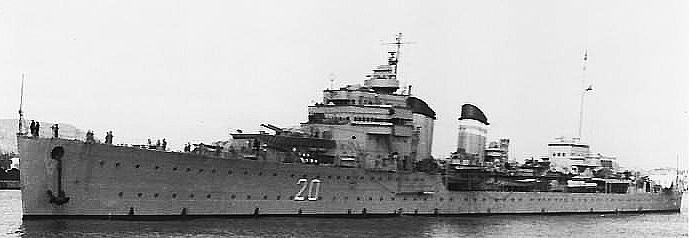
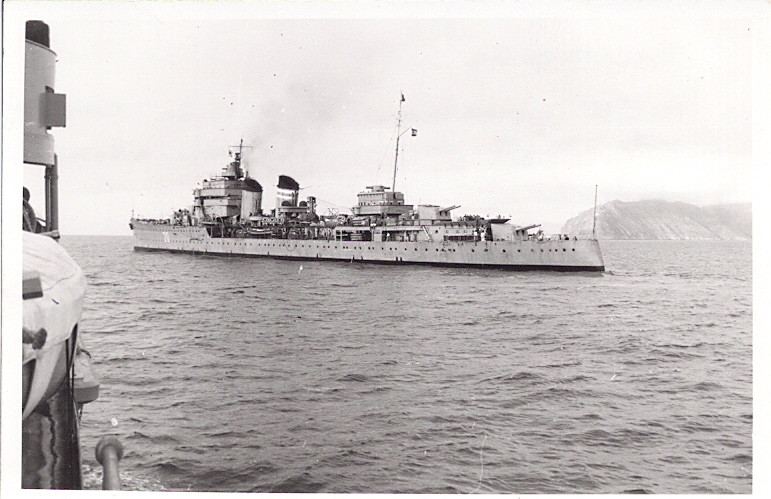
Miguel de Cervantes off Cartagena in the 1930s, by Francisco Martínez Asuar (cc).
The ships were relatively fast, Alfonso achieving 34.7 knots on trials with 83.000 hp (80,000 nominal) on forced heat. Outside their eight main guns, they also had four single 102 mm/45 AA (4 in), and two 3-pdr AA (76 mm) and two triple banks of 533 mm (21-in) TTs each side, 12 total. No provision was made to carry a reconnaissance plane. All three (Alfonso, Cervera and Cervantes) were launched in August 1925, May 1927 and February 1930 respecively. At that time their design was already dated, as they had no real turrets but shields for their main artillery. In 1931, Alfonso was renamed Libertad by the new regime. When the civil war broke out, all three were in Republican hands, but Cervera.
They participated in several actions (see above details), but Miguel de Cervantes was torpedoed, and not sunk by the Italian submarine Torricelli in 1936. She was repaired and returned to service until 1939. Both her and Libertad were interned in Bizerte and later returned to Franco’s Navy. Almirante Cervera was docked at Ferrol when she was captured by the Nationalists in 1936, then commanded by Captain Juan Sanchez-Sandalio Ferragut (not Farragut !), which was executed by the crew. Nicknamed the “Dandy of Biscay” she teamed up with battleship España and destroyer Velasco to enforce a blockade from Ferrol. Her career does not fit here and like other Spanish units will be studied in detail in a dedicated post.
 Alsedo class destroyers (1922)
Alsedo class destroyers (1922)

Ordered by the same Navy Law of 17 February 1915 as the Blas de Lezo class cruisers, the first unit, Alsedo, was laid down in 1920 in Cartagena DyD, like the Juan Lazaga and Velasco. They were launched in 1922 (October), 1924 (March) and 1923 (June) respectively. They were loosely based on the British Nimrod class. In the interwar, they received four 20 mm oerlikon guns in replacement for their old 2-pdr. They participated in the civil war on the Republican side and survived. Velasco famously sank the Nationalist-held submersible B2 off Cape Penas near Santander on 19 August 1936.
Under Franco’s Navy in 1945 they received two Deep Charge Throwers while the complement rose to 86. There was a proposal at some point to replace the ‘Y’ gun (between the funnels) by a German 88 mm AA but this never materialized. They were eventually stricken in 1957 and 1961.
 Churucca class destroyers (1926)
Churucca class destroyers (1926)
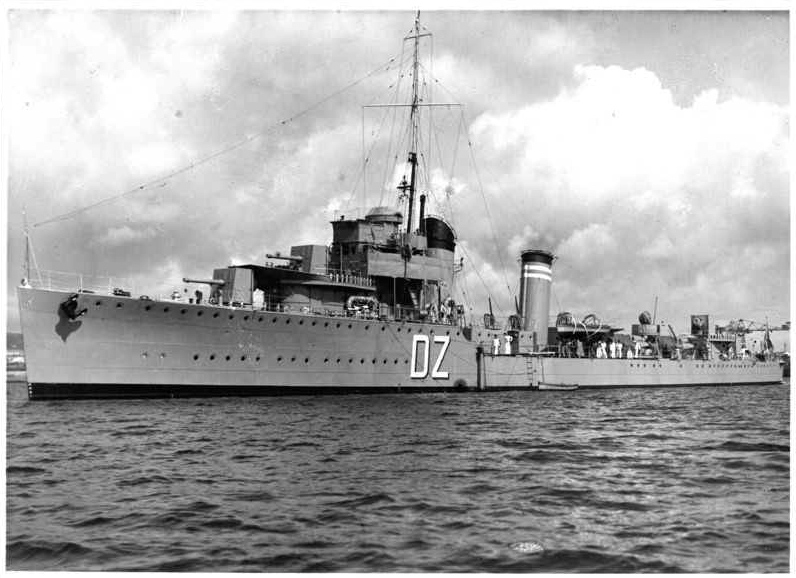
Destroyer Jose Luis Diez (1928), first group.
Still provided under the same February 1915 naval law, Nine ships (first batch) and seven (2nd batch) were ordered, and later designed as close copies of the Scott class destroyer leader. There were little differences between the two batched, launched at Cartagena (but Churucca (1) at Cadiz), in 1926-33. Two were sold in 1927 to Argentina, Alcalà Galiano and the Churucca, the name being repeated to two other destroyers of the same group. Second batch destroyers had a greater fuel storage and modified gun mountings with larger shields. Displacement was 1536-1590 standard and up to 2087-2175 tons fully loaded. Standard armament was 5-120 mm guns (4.6 in), 1x 76 mm AA, and 2×3 21-in TTs (533 mm), plus two DC throwers.
Most were active during the civil war on the Republican side, three torpedoed and sank the Cruiser Baleares. Ferrandiz was sunk by the Canarias, Ciscar by aviation at Gijon and later refloated and repaired by the Nationalists, and Diez, badly damaged by the Canarias, took refuge and was interned in Gibraltar. The last batch was composed of the Alava and Liniers, but construction was suspended and resumed much later during the latter part of WW2.

Churucca class DDs – Author’s illustration profile
 B class submarines (1921)
B class submarines (1921)
![]()
Part of the February 1915 naval law, built at Cartagena they were based on the Holland design, but modified by the British and under licence by Electric Boat Co. These 1290 tons FL boats had 533 mm (21-in) TTs instead of the puny 450 mm of the previous ‘B’ class, with two more, but sacrificed some diving and underwater speed (16/8.5 knots). They counted on 2,000 bhp Vickers engines and 750 shp electric motors and received a forward deck gun, 76 mm (3-in).
Launched in 1927-29 they were in service with the Republicans and C1 was sunk by aviation off Barcelona but later salvaged, C3 sunk off Malaga by an Italian submarine, C5 lost in the bay of Biscay. C6 was damaged by an air raid and later scuttled to avoid capture, C2 and C4 underwent a refit in France which ended too late and they were surrendered to the new regime after the end of the war. Meanwhile, the older ‘B’ class submarines (launched 1922-23, 494/715 tons, 62.5 x 5.6 x 3.4 m) derived from the Isaac peral, a Holland-type of 1916, were also in Republican hands. Four were scuttled in Cartagena and Pormon at the end of the war in April 1939, while B5 was sunk by an aircraft in 12.10.1936 and B6 in 19.9.1936. B2 was later refloated and used to reload batteries until 1948.
 Jupiter class minelayers (1935)
Jupiter class minelayers (1935)
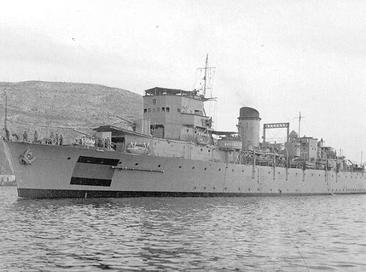
The Jupiter as completed, wearing neutrality bands during WW2. These 2,100/2,600 tons ships 100 m long (12.65 x 3.50 m) were propelled by two shafts Parsons turbines and two Yarrow boiler for a total of 5000 shop, enough to reach 18.5 knots. They could carry 264 mines and in supplement to their four 120 mm, 2x 75 mm and four 20 mm AA guns, also carried two DC throwers. They were dual-purpose vessels launched in 1935-37 at Ferrol and completed in 1937-38. Their guns were in superfiring positions and the mines ran on four rails in a fully covered mine deck, launched from transom doors. Vulcano and Jupiter were modernized in 1959-61 as Frigates and they were reclassified as frigates, stricken in 1972-77. Little is known about their civil war service, which was short due to their late completion.
 Gunboat Calvo Sotelo (1934)
Gunboat Calvo Sotelo (1934)
This gunboat was ordered by the Mexican government as Zacatecas, built at Echavarriera y Larrinaga (Cadiz). She was requisitioned when the civil war broke out by the Republican government and pressed into service only in August 1938. Specs: 1,600/2,000 tons FL, 92.35 m oa x 12.20 x 3.05 m, 4x 102 mm, 2x 75 mm, 3x 20 mm AA. She served under Spanish color until 1957. Eventually her sister-ship Durango ws delivered to the Mexicans.
 Seaplane tender Dédalo (1901)
Seaplane tender Dédalo (1901)
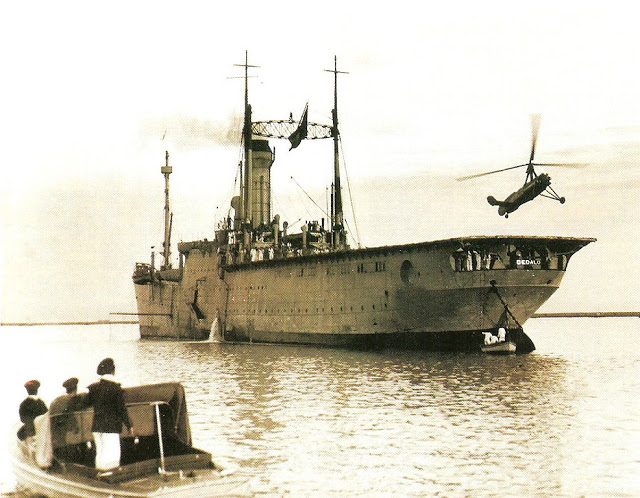
First helicopter carrier ? An autogyro taking of from Dédalo; This was in effect the first rotorcraft to take off and land on the deck of a ship, 7 March 1934.
This auxiliary ship was hardly the first Spanish “Aicraft carrier” as the type arrived much later during the cold war, but it was used operationally both during the Rif war. However she was already disposed of during the civil war (laid up for disposal in 1935 in Sagunto), sunk by Nationalist aviation to avoid her conversion back as a seaplane carrier. She was the former Neuenfels, a merchant vessel of 1901 converted in 1922 to accomodate an airship, two balloons, and several seaplanes, complete with a hangar and cranes. The airship had a mooring mast installed at the forward end of the forecastle. She was refloated in 1940 and scrapped in Valencia.

Illustration of the Dédalo in 1922 by Erlenmeyer, 2015 (CC).
During the 1960-70s, a former Independance class aircraft carrier was loaned to Spain from 1967 under MDAP, under the same name. She served until 1989 as SPS Dédalo R-01. >
Ships of the Nationalist Navy

 Battleship España (Former Alfonso XIII)
Battleship España (Former Alfonso XIII)
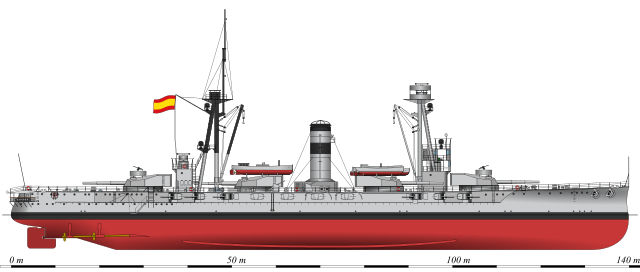
Battleship España was lost off cape Tres, Morocco. The name went to Alfonso XIII in 1931 after the change of regime. Completed in August 1915 she took part in the Rif war. In 1934 she was laid up at Ferrol potentially waiting for a modernization in the Italian style. But it never took place because of budget constrains. When Franco started his rebellion against the regime, España was still in Ferrol’s drydock, with the completion of her modernization nearly done.
However Ferrol soon fell to the Nationalists, and a quasi-mutiny took place with the ships present, crews taking on their officers, seizing the ships and starting battle preparations to shell Nationalist forces in the harbour. The battleship soon turned against shore batteries and the Nationalist destroyer Velasco. However there was no escape and support in the harbor was strong, leading to a “siege”. Eventually the España’s crew surrendered, without any hope of relief, short of water, food and ammunitions. This in-habour battle left Ferrol devastated. Both the port and captured ships needed much repairs.
After several month, España returned in active service, this time under Nationalist flag. She teamed up for her first mission with Almirante Cervera and Velasco, and started rampaging the coast, targeting merchant Republican traffic. They also took on foreign merchant ships, provoking much international indignation. But by this point, Europe was wildly divided about the subject as the war was also a class and political war. However on February 1937, while interdicting British steamer SS Consett to enter Santander she struck a mine and sank slowly enough for her entire crew to be saved by Velasco.
 Baleares class Cruisers (1936)
Baleares class Cruisers (1936)
These impressive heavy cruisers has been started during the Carlist regime, based on plans prepared by the same engineer behind the design of the British County class. However the span of contruction was such that none were completed when the civil war broke out. They were captured at Ferrol and completed by the Nationalists.
Both were a crucial asset in their fleet, since thay lacked any battleship. They became very active understandably, participating in many operations. Of the two, Baleares was the only sunk, by three Republican destroyers (Barcaiztegui, Lepanto, Artequera) off Cape Palos on 6.3.1938. Canarias survived the civil war, spend WW2 as flagship of the Spanish Navy, was modernized in 1952-53, 1960, and the late 1960s with modern electronics before being stricken in 1975 and scrapped in 1978. Read More about the Canarias class
 Cruiser Navarra (1920)
Cruiser Navarra (1920)
Reina Victoria Eugenia was a 1920 cruiser of the prewar british “Town” class design. She was renamed Republica in 1931 and then Navarra after her 1937-38 reconstruction, in Nationalist service. This was carried out at Cadiz, where she was fitted with 8 new Yarrow boilers trunked into two new vertical funnels and the superstructure was rebuilt to include a new streamlined bridge and small vertical foremast aft. The main armament was reduced to 6 of the original 9-150 mm (6-in) guns in superfiring axial positions and AA was revised.
However when she was out again, there was little to do left and the 4857t standard, 6500t fully loaded cruiser unable to follow the more modern and faster Canarias and Almirante Cervera. She was mostly inactive also during WW2 and discarded eventually in 1956 after being used for training most of her career. More on the Navarra
 Cruiser Almirante Cervera (1925)
Cruiser Almirante Cervera (1925)

Captured in Ferrol, same class as the Alfonso and Cervantes (see above Republican navy). She served for the whole conflict and in 1940-46 as her sister-ships her armament was modernized, with four 105 mm, 8x 37 m, 4x 20 mm AA, new fire control, reworked, larger bridge, short pole mast and displacement up to 9660 tons fully loaded. Galicia (ex. Libertad) and Cervantes both had their central 150 mm gun replaced by a catapult and cranes for a reconnaissance plane. Their armament was modified again, with the adoption of four twin 90 mm DP and twenty 20 mm AA guns in 1946 while the TTs were removed, reaching 9900 tons fully loaded. They were stricken in 1960-70.
 Castillo class gunboats (1922)
Castillo class gunboats (1922)
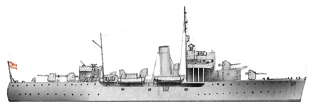
Castillo class Gunboats – Author’s illustration profile
The Castillo class ships were 1314 tons standard, launched 1922-23, armed with four 102 mm guns under masks, not in superfiring positions because of stability issues but rather on the same level. The class comprised the Antonio Canovas del Castillo, José Canalejas and Eduardo Dato, all launched at Cartagena after the war and their names were shortened in the 1930s. Outside their main guns they received two saluting 47 mm guns, and two Pom-Pom Bofors with carriages allowing to be used on land. All three served during the civil war on the Nationalist side, captured early on.After the war they received two 3-in AA guns.
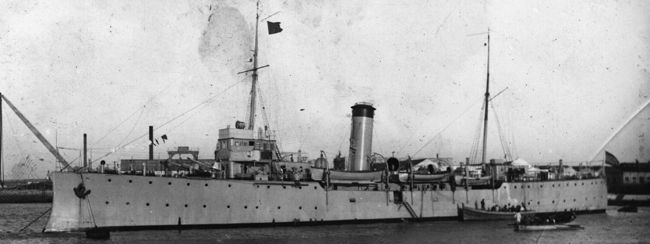
Gunboat Canovas del castillo – Coll.Juan Antonio Padron Albornoz, Universidad de La Laguna (Tenerife) Source vidamaritima.com
Other Spanish Gunboats
Besides the above Spain still had a few old gunboats built during 1885-97, all except one of which (the 114t Macmahon) were discarded in the 1920s, and two discarded 1930s old river gunboats, Perla (1887, 42t) and Cartagener (1908, 27t). There were also patrol ships discarded in 1930s, eleven purpose-built armed trawlers purchased in 1922 of:
-The ‘Castle’ class, Uad Lucas (ex-HMS Ness), Uad Muluya (ex-HMS Waveney), Uad Ras (ex-HMS Wear), Uad Martin ex-HMS Erne) and Uad Targa (ex-HMS Test).
-The Mersey class Uad Quert (ex-HMS Rother), Xauen (ex-HMS Henry Cromvell) and Arcilla (ex-HMS William Doak)
-The Briscard class Tetuan (ex-French Grognard), Larache (ex-French Poilu) and Alcazar (ex-French Rengage).
-Cabo Fradera, a 45 tons river gunboat was captured by the Nationalists and commissioned as a patrol ship.
Uad Targa was wrecked 1.9.31 and Uad Ras was lost in 1933, whilst Uad Lucas and Uad Muluya were sunk by the cruiser Cervera on 10.11.36. The remainder were discarded between 1944 and 1965. There were also three coastguard fishery units from 1910-11, displacing 158t.
The Laya, sunk by Nationalist aircraft at Valencia, was salvaged in 1940 and scrap protection vessels, Delfin, Dorado and Gaviotab were shortened after completion by wth 1-57mm gun and with a speed of 11kts, and an ocean-going tug, Anteio, from the first world war. Dato was sunk by the battleship Jaime Primero, by then equipped for minelaying and minesweeping. Delfin and Dorado were discarded in the 1920s and Gaviota and Antelo in the 1930s.
WW2 Spanish Navy
Although neutral, Spain still kept a number of significant warhips in service, that could have taken out a blocus of Gibraltar if needed. The only participation of Franco to the axis cause was to sent a contingent in USSR, the Azul Division. They were primarily equipped by the Germans, but no Spanish ships participated in any axis operation. On paper however, this fleet was a considerable asset, at least in the eyes of Hitler in case of an attempt to takeover Gibraltar which would have far-reaching consequences for WW2.
-Heavy Cruiser Canarias (1936)
-Three Alfonso class cruisers (1923)
-Mendez Nunez (taken in hand in 1944 for reconstruction)
-Three Alsedo class destroyers (1922)
-Thirteen Churucca class destroyers (1926-33)
-Four Aquila class destroyers (ex-Italian, transferred 1938)
-Two Castillo class gunboats (1922)
-Seven 177 tons TBs (1917)
-Holland type Submarine B2 (used for training)
-Two C class submarines (1928)
-Gunboat calvo Sotelo (1934)
-Four Jupiter class Gunboat/Minelayers (1935-36)
-Two Eolo class minelayers (1939)
-40 misc. ships: M1 class CMBs, DAR ex-G5 soviet type MTBs, ex-Italian MAS transferred 1937, LT class ex-German S-Boote MTBs, locally built LT-27 class (completed from 1944 and well after the war).
In construction:
-Eight Pizarro class gunboats (1944) completed postwar
-Three D class submarines (German design, 1944), completed postwar
-Seven Bidasoa class minesweeprs (German M-Boat design 1943-44) completed postwar
Post-WW2 Spanish Navy
Franco’s regime completed a number of ships which construction or refit has been suspended. They would be treated in detail in the future cold war section of the Armada.
-AA Cruiser Mendez Nunez (1947)
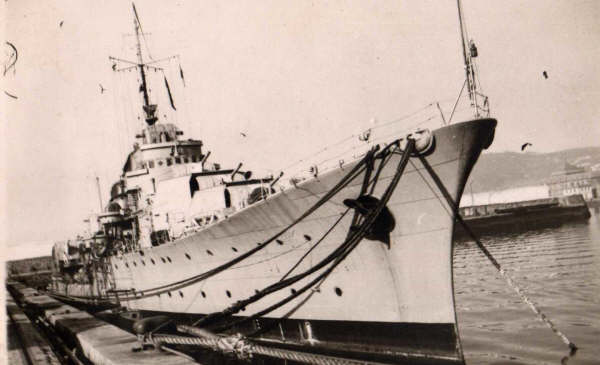
The old 1922 cruiser was completely rebuilt as an AA cruiser from 1944 to 1947: 8x 120 mm shielded, six single mounts in axis double superfiring platforms fore and aft and two both sides of the rear superstructure, 10x 37 mm in twin mounts abaft the funnels and behind, plus 8x 20 mm AA guns and six (2×3 banks) 533 mm torpedo tubes. It was said the 1941 Atlanta class was the main inspiration for this design. The bow was also rebuilt as a clipper bow, increasing lenght to 7 feets while displacement rose to 4680 tons (more on the cold war Armada section).
-Alava class destroyers (1946)
Originally the third batch of Churucca class destroyers which construction was started in Cartagena just when the civil war broke out. It was suspended and resumed in 1939, then supended again, the hulls were laid down in 1944-45 and completion made after WW2, in 1946 and 1947 for Alavia and Liniers. These 101 m, 1670 tons destroyers were modelled on 1930s British designs and completely obsolete when entering service. Despite of this, and several refits, they stayed active until 1978-80. This was not the case for the Ocquendo class, completed in the early 1960s on a completely revised design.
-Audaz class TBs (1951)
These ships were based on the French Le Fier class design TBs. These were nine ships in 1945 but completed in 1951 up to 1961. Needless to say, based on a late 1930s design they were totally obsolete in the 1960s, but served in the 1970s and for Intrepido, 1980. See the cold war section.
Read More
Beevor, Antony (2000) The Spanish Civil War.
Conway’s all the world’s fighting ships 1906-1921 and 1922-1947
Fernández, Carlos (2000). Alzamiento y Guerra civil en Galicia 1936–1939. Vol.1.
Moreno de Alborán y de Reyna, Salvador (1998). La guerra silenciosa y silenciada: historia de la campaña naval durante la guerra de 1936-39. Vol.3.
Basque ships on marinavasca.eu
Basque Navy on sbhac.net
The Armada on hazegray.org
en.wikipedia.org/ Basque_Auxiliary_Navy
grijalvo.com Nabara
errepublika.org republica_Euskadi
revistanaval.com
todoababor.es
losbarcosdeeugenio.com
on perso.wanadoo.es
kbismarck.com/ spanishcivwar
Photo archives (web.archive.org)
wikiwand.com/ Spanish_Republican_Navy
sectormaritimo.es/ plans

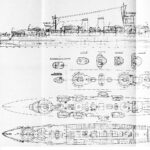
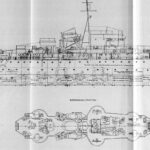
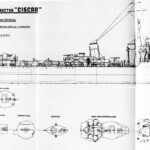
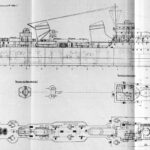
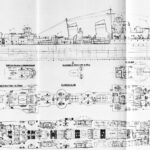
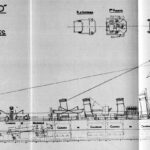
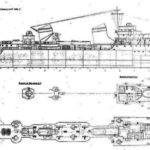
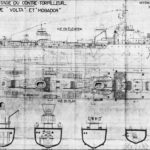
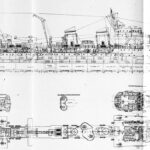
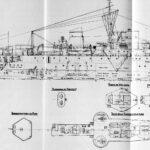
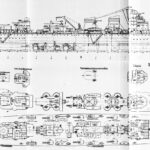

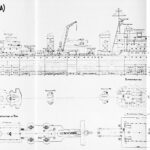

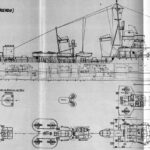
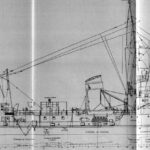

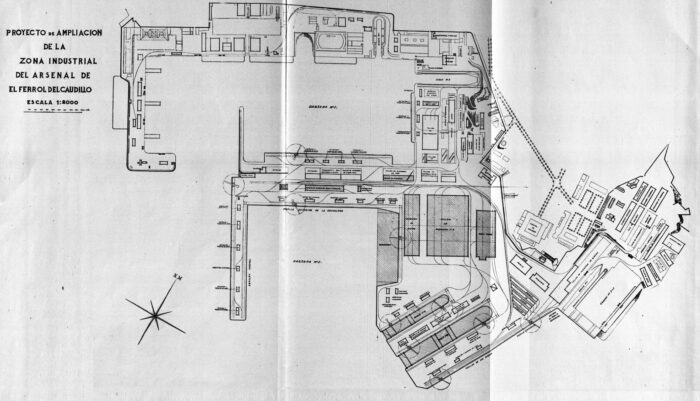
 Latest Facebook Entry -
Latest Facebook Entry -  X(Tweeter) Naval Encyclopedia's deck archive
X(Tweeter) Naval Encyclopedia's deck archive Instagram (@navalencyc)
Instagram (@navalencyc)





 French Navy
French Navy Royal Navy
Royal Navy Russian Navy
Russian Navy Armada Espanola
Armada Espanola Austrian Navy
Austrian Navy K.u.K. Kriegsmarine
K.u.K. Kriegsmarine Dansk Marine
Dansk Marine Nautiko Hellenon
Nautiko Hellenon Koninklije Marine 1870
Koninklije Marine 1870 Marinha do Brasil
Marinha do Brasil Osmanlı Donanması
Osmanlı Donanması Marina Do Peru
Marina Do Peru Marinha do Portugal
Marinha do Portugal Regia Marina 1870
Regia Marina 1870 Nihhon Kaigun 1870
Nihhon Kaigun 1870 Preußische Marine 1870
Preußische Marine 1870 Russkiy Flot 1870
Russkiy Flot 1870 Svenska marinen
Svenska marinen Søværnet
Søværnet Union Navy
Union Navy Confederate Navy
Confederate Navy Armada de Argentina
Armada de Argentina Imperial Chinese Navy
Imperial Chinese Navy Marinha do Portugal
Marinha do Portugal Mexico
Mexico Kaiserliche Marine
Kaiserliche Marine 1898 US Navy
1898 US Navy Sovietskiy Flot
Sovietskiy Flot Royal Canadian Navy
Royal Canadian Navy Royal Australian Navy
Royal Australian Navy RNZN Fleet
RNZN Fleet Chinese Navy 1937
Chinese Navy 1937 Kriegsmarine
Kriegsmarine Chilean Navy
Chilean Navy Danish Navy
Danish Navy Finnish Navy
Finnish Navy Hellenic Navy
Hellenic Navy Polish Navy
Polish Navy Romanian Navy
Romanian Navy Turkish Navy
Turkish Navy Royal Yugoslav Navy
Royal Yugoslav Navy Royal Thai Navy
Royal Thai Navy Minor Navies
Minor Navies Albania
Albania Austria
Austria Belgium
Belgium Columbia
Columbia Costa Rica
Costa Rica Cuba
Cuba Czechoslovakia
Czechoslovakia Dominican Republic
Dominican Republic Haiti
Haiti Hungary
Hungary Honduras
Honduras Estonia
Estonia Iceland
Iceland Eire
Eire Equador
Equador Iran
Iran Iraq
Iraq Latvia
Latvia Liberia
Liberia Lithuania
Lithuania Mandchukuo
Mandchukuo Morocco
Morocco Nicaragua
Nicaragua Persia
Persia San Salvador
San Salvador Sarawak
Sarawak Uruguay
Uruguay Venezuela
Venezuela Zanzibar
Zanzibar Warsaw Pact Navies
Warsaw Pact Navies Bulgaria
Bulgaria Hungary
Hungary

 Bundesmarine
Bundesmarine Dutch Navy
Dutch Navy Hellenic Navy
Hellenic Navy Marina Militare
Marina Militare Yugoslav Navy
Yugoslav Navy Chinese Navy
Chinese Navy Indian Navy
Indian Navy Indonesian Navy
Indonesian Navy JMSDF
JMSDF North Korean Navy
North Korean Navy Pakistani Navy
Pakistani Navy Philippines Navy
Philippines Navy ROKN
ROKN Rep. of Singapore Navy
Rep. of Singapore Navy Taiwanese Navy
Taiwanese Navy IDF Navy
IDF Navy Saudi Navy
Saudi Navy Royal New Zealand Navy
Royal New Zealand Navy Egyptian Navy
Egyptian Navy South African Navy
South African Navy






























 Ukrainian Navy
Ukrainian Navy dbodesign
dbodesign